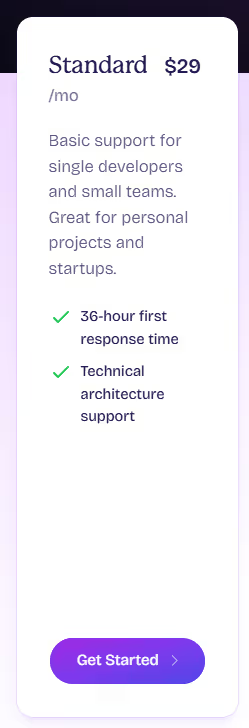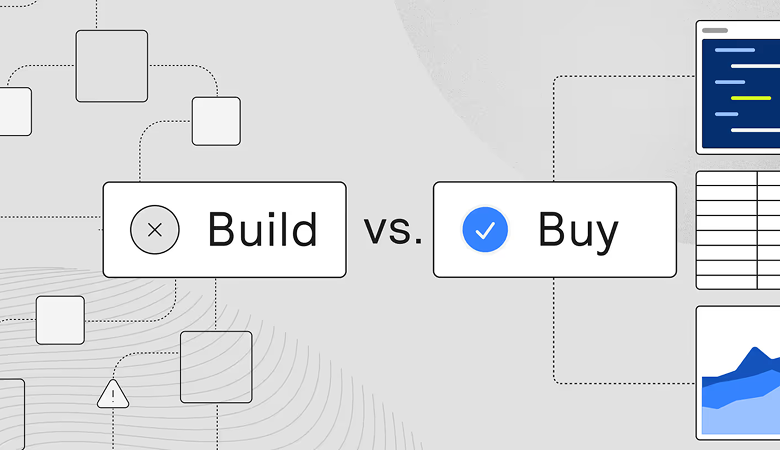Fly.io runs apps close to users on a global network, making it a popular choice for fly hosting among developers. The platform charges on a usage basis for compute, storage, and bandwidth, with optional support tiers.
Fly.io pricing in 2025 is primarily usage-based, with standard support plans starting at $29 per month. Fly.io pricing ranges from effectively $0 (for tiny hobby usage) up to enterprise-level spend with premium support, depending on usage and support needs.
This guide explains Fly.io features and pricing so you can understand its pricing models in 2025 at a glance.
Note: For the most up-to-date pricing, check Fly.io’s official pricing page. Plan details may change over time.
What are Fly.io’s pricing models?
Below is a breakdown of each available Fly.io pricing plan as of 2025, what it offers, and who it’s built for.
Pay-as-you-go
There’s no monthly fee. Users pay based on what their app consumes: virtual machines (billed per second), storage (at $0.15 per GB per month), and outbound bandwidth (starting at $0.02 per GB).
Fly.io no longer offers a general free tier for new organizations. While new accounts don’t include a free plan, documentation still references Fly.io free tier features for legacy users who retained early allowances.
Key features:
- Full access to Fly Machines, regions, and CLI
- Unlimited apps, orgs, and team members
- Access to an active community forum with peer support; direct support available from $29/month
- Best-effort reliability with higher SLA options available on Enterprise plans
- Account setup includes a verified payment method for security and accurate billing
Standard support ($29/month)

Basic support plan with a 36-hour response time and technical architecture assistance, ideal for solo developers and early-stage teams.
Standard is the first paid tier. It focuses on giving small teams access to help without jumping into high-cost support.
Key features:
- Email support with 36-hour response SLA
- Technical guidance on architecture
- Full access to Fly.io infrastructure and features
- No usage credits included
- No dedicated contact or real-time support
Premium support ($199/month)

Better support with faster response times, dedicated Slack access, and quarterly architecture reviews for scaling apps.
Premium adds faster, more hands-on support and visibility into how apps perform on Fly.io.
Key features:
- 24-hour ticket response time
- 1-hour urgent issue response
- Private Slack channel with the Fly.io team
- Quarterly architecture review sessions
- Dedicated support contacts
Enterprise support ($2,500+/month)

Top-tier support with 24/7 response coverage, 15-minute emergency SLAs, and dedicated engineering contacts for mission-critical workloads.
Enterprise is designed for teams with 24/7 uptime needs and security compliance.
Key features:
- 24/7 support with a 4-hour response guarantee
- 15-minute emergency SLA
- Private Slack and/or phone access
- Dedicated account manager and engineers
- Priority access to platform features
- Compliance and audit support
Remember: For the most updated pricing info, always check Fly.io’s pricing site.
Tailscale pricing on Fly.io
Fly.io supports private networking with Tailscale, which allows secure, encrypted communication between machines without writing any VPN configs.
How does Tailscale pricing work on Fly.io?
Tailscale itself offers a free tier and paid business plans, but on Fly.io, users don’t pay extra to enable WireGuard tunnels between Fly-hosted machines in their app. That means:
- Encrypted machine-to-machine communication is included at no setup cost.
- Cross-region private network transfer is billed per GB (rates vary by region group).
- If users integrate with external Tailscale networks or ACLs, they’ll need a Tailscale business plan.
Note: Explore common pricing models for products in our dedicated post on the subject. For context on other no-code tools, you should look into Glide pricing.
Key elements of Fly.io’s pricing approach
Here’s a quick overview of Fly.io’s usage-based elements and their pricing.
Compute (VMs)
Machines are billed per second. A shared 256 MB instance costs approximately $0.0027 per hour, or around $1.94 per month if it runs continuously. Larger instances scale in a predictable, linear cost structure, making budgeting simpler.
Storage
Persistent volumes are priced at $0.15 per GB per month. Users pay for provisioned size, whether it’s full or not, and storage costs continue even if the VM is stopped.
Bandwidth
Outbound data starts at $0.02 per GB in North America and Europe. Other regions can cost up to $0.12 per GB. Inbound bandwidth is free. Inbound traffic and same-region app/machine traffic remain free under granular rates
Add-ons and services
Services like Fly Postgres, Redis, and object storage are charged separately. A small database may cost $2 to $5 per month. High-availability setups can cost $80 or more per month.
Note: To estimate the monthly bill more accurately, users can try the Fly.io pricing calculator. It lets them input machine sizes, hours, bandwidth, storage, and support options to see a real-time cost preview.
Why do companies like Fly.io adopt usage-based billing?
Usage-based billing suits platforms that meter infrastructure. It ties price to actual consumption and encourages user adoption. Here is why teams choose it:
- Align spend with usage: Customers pay for what they run. The bill tracks compute, storage, and bandwidth in clear units.
- Reduce friction to start: Small apps launch with a tiny footprint. Spend grows only when usage grows.
- Scale with unpredictable traffic: Spikes during launches or regional bursts translate to higher usage only when they happen. Quiet periods lower spending automatically.
- Give clear levers to engineering: Instance size, replicas, and data transfer map directly to line items that the team observes. Choices in architecture show up in the invoice. Fly’s detailed billing makes it easy to track line items, so teams can quickly reconcile and invoice Fly usage within their workflows.
- Support global footprints: Workloads move closer to users without a plan change. Pricing follows the resources used in each region.
- Keep product and finance aligned: The same events that power operations feed revenue metrics and forecasts. Everyone works from a single set of numbers.
Note: For a practical overview of when to mix subscriptions with meters, read our hybrid pricing guide.
Why is usage-based billing becoming the default?
Buyers expect bills that reflect the value they receive. The model scales across customer sizes and workloads without reworking plans. This approach ties directly into modern cloud billing expectations, where costs reflect real consumption rather than fixed tiers.
Here are some reasons why usage-based billing is growing in popularity.
Align price with product value
Usage ties spend to outcomes. When customers process more requests, store more data, or transfer more bytes, the price follows that activity. This builds trust because units match how teams experience value in production. Procurement reviews a clear mapping from usage to cost.
Support unpredictable workloads
Traffic shifts by region, time, and feature rollouts. Seasonal peaks and launch surges push usage up only when they occur. Quiet periods pull usage down without manual adjustments. Teams avoid plan changes and can stay focused on performance and reliability.
Keep pricing flexible as features evolve
Companies ship new capabilities often. Metered building blocks let teams introduce, package, and iterate on features without reworking legacy tiers. Finance updates rates or thresholds while engineering ships improvements. Pricing evolves at the same pace as the product.
Connect billing with ops and finance
The same events that drive operations drive invoicing and reporting. Usage flows into revenue, margin, and forecast models. Leaders review one source of truth for volume, cost, and price. Decisions move faster because the data stays consistent across tools.
Note: If you plan to test meters, thresholds, or free allowances, explore our guide to pricing experiments. It covers experiment design, guardrails for revenue, and a simple launch checklist.
FAQs
How do you use Fly.io’s deployment calculator?
You can use Fly.io’s deployment calculator to estimate monthly costs based on VM sizes, hours, bandwidth, storage, and support levels. Just input your expected usage, and it shows a real-time price preview.
Is Fly.io open source?
Fly.io itself is not fully open source, but it supports and contributes to open-source tools like the Fly.io CLI and Nix-based build systems. Many of its building blocks are open or self-hostable. However, the full Fly platform is proprietary.
Where does Fly.io run?
Fly.io runs applications on its global edge network, with data centers in over 30 regions across North America, Europe, Asia, and more. You can deploy apps close to your users for better latency. Specific regions can be selected per deployment.
Learn how Orb supports usage-based billing
Orb helps teams launch and manage usage-based pricing. You can define billing metrics with the Orb SQL Editor or a visual editor and build new pricing plans without engineering.
Orb ingests and tracks every raw event so invoices remain accurate and transparent as your pricing evolves. It also enables forecasting and supports workflows across finance, product, and ops. Here’s how Orb can help you launch pricing models and evolve them over time:
- Test pricing changes before you commit: With Orb Simulations, you can test pricing models using historical usage data. Run parallel pricing scenarios, forecast revenue impact, and compare performance, all without deploying code changes.
- Define pricing with ease: With Orb SQL Editor and visual editor, business and product teams can define billable metrics based on any usage event, whether that’s compute hours, API calls, or outbound data. No hardcoded logic. No reliance on dev time.
- Generate accurate invoices: Orb reduces billing errors by turning raw usage data into auditable invoices. By performing calculations based on raw data, Orb ensures that your pricing updates are accurately reflected in customer bills without friction or guesswork.
- Stay agile with version control and rollout tools: Orb helps you manage pricing like a product. Whether you're introducing a new tier or revising how you charge for storage, Orb makes it simple to test, iterate, and ship changes safely.
- Empower finance and product: Orb’s platform works across teams. Finance gets reporting and revenue attribution, while the product team can experiment with pricing without waiting on engineering.
If you want to launch your pricing models with confidence, Orb helps you do it without complex engineering. Explore Orb’s flexible pricing tiers.

.avif)

